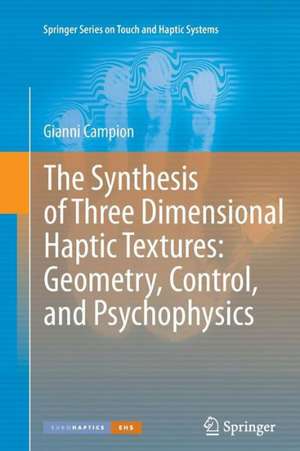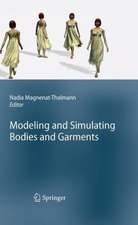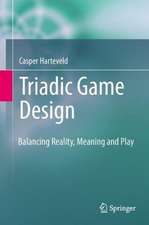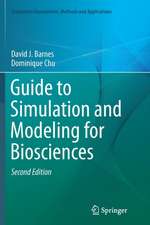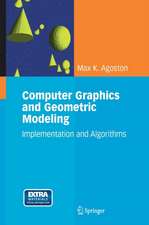The Synthesis of Three Dimensional Haptic Textures: Geometry, Control, and Psychophysics: Springer Series on Touch and Haptic Systems
Autor Gianni Campionen Limba Engleză Paperback – 12 iul 2013
This book formalizes the specific artefacts corrupting the rendering of virtual haptic textures and offers a set of simple conditions to guide haptic researchers towards artefact-free textures. The conditions identified are also extremely valuable when designing psychophysical experiments and when analyzing the significance of the data collected.
The Synthesis of Three Dimensional Haptic Textures, Geometry, Control, and Psychophysics examines the problem of rendering virtual haptic textures with force feedback devices. The author provides an introduction to the topic of haptic textures that covers the basics of the physiology of the skin, the psychophysics of roughness perception, and the engineering challenges behind haptic textures rendering. The book continues with the presentation of a novel mathematical framework that characterizes haptic devices, texturing algorithms and their ability to generate realistic haptic textures. Finally, two psychophysical experiments link the perception of roughness with the parameters of the haptic rendering algorithms.
This book formalizes the specific artefacts corrupting the rendering of virtual haptic textures and offers a set of simple conditions to guide haptic researchers towards artefact-free textures. The conditions identified are also extremely valuable when designing psychophysical experiments and when analyzing the significance of the data collected.
| Toate formatele și edițiile | Preț | Express |
|---|---|---|
| Paperback (1) | 584.91 lei 38-44 zile | |
| SPRINGER LONDON – 12 iul 2013 | 584.91 lei 38-44 zile | |
| Hardback (1) | 645.97 lei 43-57 zile | |
| SPRINGER LONDON – 18 mai 2011 | 645.97 lei 43-57 zile |
Din seria Springer Series on Touch and Haptic Systems
- 20%
 Preț: 642.65 lei
Preț: 642.65 lei - 20%
 Preț: 643.50 lei
Preț: 643.50 lei - 20%
 Preț: 302.30 lei
Preț: 302.30 lei - 20%
 Preț: 919.05 lei
Preț: 919.05 lei - 20%
 Preț: 689.83 lei
Preț: 689.83 lei - 20%
 Preț: 642.52 lei
Preț: 642.52 lei - 20%
 Preț: 644.33 lei
Preț: 644.33 lei - 20%
 Preț: 638.37 lei
Preț: 638.37 lei - 20%
 Preț: 644.33 lei
Preț: 644.33 lei - 20%
 Preț: 644.98 lei
Preț: 644.98 lei - 20%
 Preț: 338.16 lei
Preț: 338.16 lei - 20%
 Preț: 337.52 lei
Preț: 337.52 lei - 20%
 Preț: 332.24 lei
Preț: 332.24 lei - 20%
 Preț: 651.75 lei
Preț: 651.75 lei - 20%
 Preț: 603.89 lei
Preț: 603.89 lei - 20%
 Preț: 367.61 lei
Preț: 367.61 lei - 20%
 Preț: 588.39 lei
Preț: 588.39 lei - 20%
 Preț: 763.83 lei
Preț: 763.83 lei - 20%
 Preț: 1035.18 lei
Preț: 1035.18 lei - 20%
 Preț: 923.16 lei
Preț: 923.16 lei
Preț: 584.91 lei
Preț vechi: 731.14 lei
-20% Nou
Puncte Express: 877
Preț estimativ în valută:
111.92€ • 117.15$ • 93.15£
111.92€ • 117.15$ • 93.15£
Carte tipărită la comandă
Livrare economică 26 martie-01 aprilie
Preluare comenzi: 021 569.72.76
Specificații
ISBN-13: 9781447126546
ISBN-10: 1447126548
Pagini: 180
Ilustrații: XX, 160 p.
Dimensiuni: 155 x 235 x 9 mm
Greutate: 0.26 kg
Ediția:2011
Editura: SPRINGER LONDON
Colecția Springer
Seria Springer Series on Touch and Haptic Systems
Locul publicării:London, United Kingdom
ISBN-10: 1447126548
Pagini: 180
Ilustrații: XX, 160 p.
Dimensiuni: 155 x 235 x 9 mm
Greutate: 0.26 kg
Ediția:2011
Editura: SPRINGER LONDON
Colecția Springer
Seria Springer Series on Touch and Haptic Systems
Locul publicării:London, United Kingdom
Public țintă
ResearchCuprins
Introduction.- Literature Review.- The Pantograph Mk-II: A Haptic Instrument.- Fundamental Limits.- On the Synthesis of Haptic Textures.- Passive Realization of Nonlinear Virtual Environments.- Texturing Curved Surfaces.-Roughness of Virtual Textures and Lateral Force Modulation.- Calibration of Virtual Haptic Texture Algorithms.- Conclusions.
Textul de pe ultima copertă
The sense of touch is fundamental during the interaction between humans and their environment; in virtual reality, objects are created by computer simulations and they can be experienced through haptic devices. In this context haptic textures are fundamental for a realistic haptic perception of virtual objects.
The Synthesis of Three Dimensional Haptic Textures, Geometry, Control, and Psychophysics examines the problem of rendering virtual haptic textures with force feedback devices. The author provides an introduction to the topic of haptic textures that covers the basics of the physiology of the skin, the psychophysics of roughness perception, and the engineering challenges behind haptic textures rendering. The book continues with the presentation of a novel mathematical framework that characterizes haptic devices, texturing algorithms and their ability to generate realistic haptic textures. Finally, two psychophysical experiments link the perception of roughness with the parameters of the haptic rendering algorithms.
This book formalizes the specific artefacts corrupting the rendering of virtual haptic textures and offers a set of simple conditions to guide haptic researchers towards artefact-free textures. The conditions identified are also extremely valuable when designing psychophysical experiments and when analyzing the significance of the data collected.
The Synthesis of Three Dimensional Haptic Textures, Geometry, Control, and Psychophysics examines the problem of rendering virtual haptic textures with force feedback devices. The author provides an introduction to the topic of haptic textures that covers the basics of the physiology of the skin, the psychophysics of roughness perception, and the engineering challenges behind haptic textures rendering. The book continues with the presentation of a novel mathematical framework that characterizes haptic devices, texturing algorithms and their ability to generate realistic haptic textures. Finally, two psychophysical experiments link the perception of roughness with the parameters of the haptic rendering algorithms.
This book formalizes the specific artefacts corrupting the rendering of virtual haptic textures and offers a set of simple conditions to guide haptic researchers towards artefact-free textures. The conditions identified are also extremely valuable when designing psychophysical experiments and when analyzing the significance of the data collected.
Caracteristici
The literature review is a synthetic and complete introduction to haptic textures for the researchers unfamiliar with the field. The mathematical analysis of the texture algorithms guides the design of stable (non vibrating) haptic textures and yields a very practical design tool. It provides analytical tools for understanding the range of textures that a haptic device can render. Includes supplementary material: sn.pub/extras
